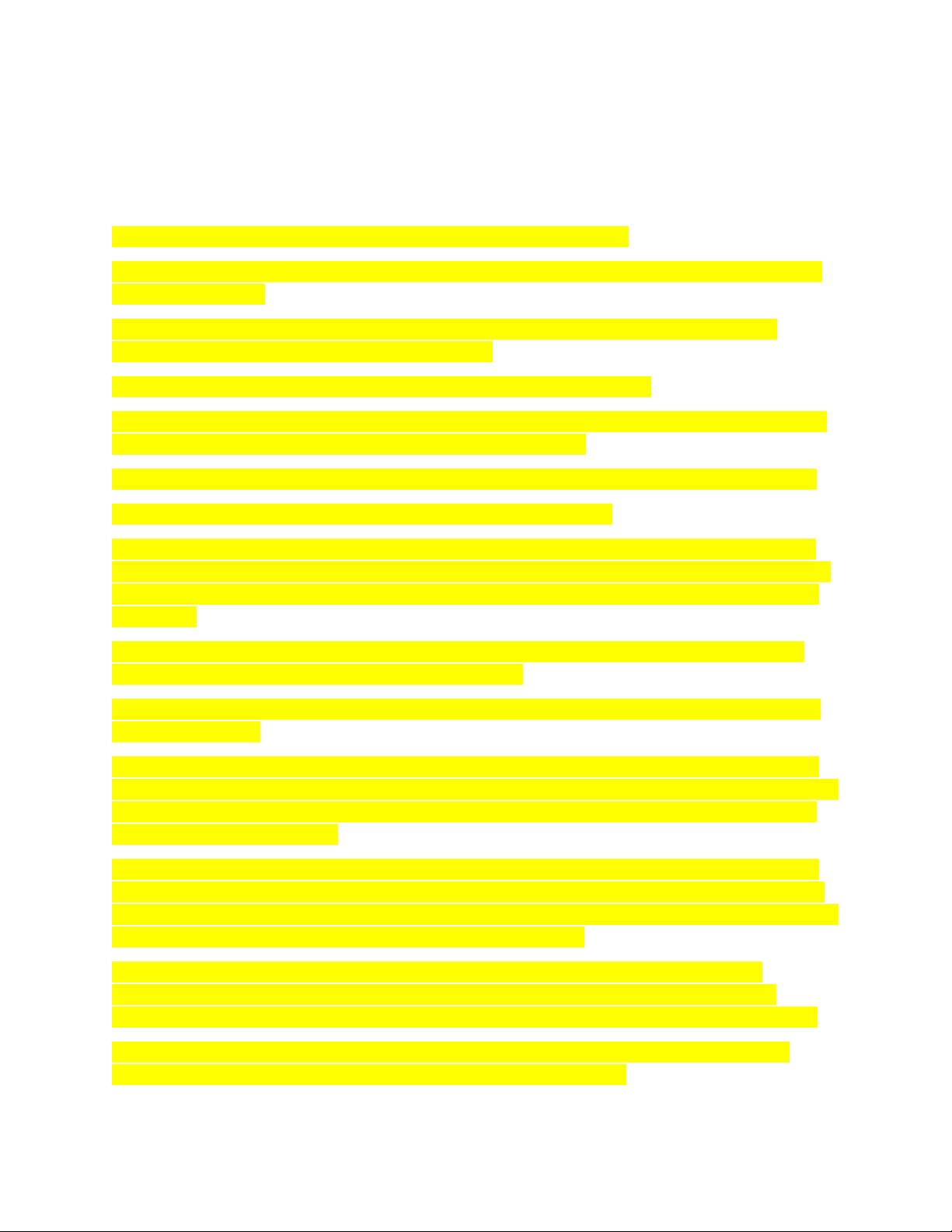
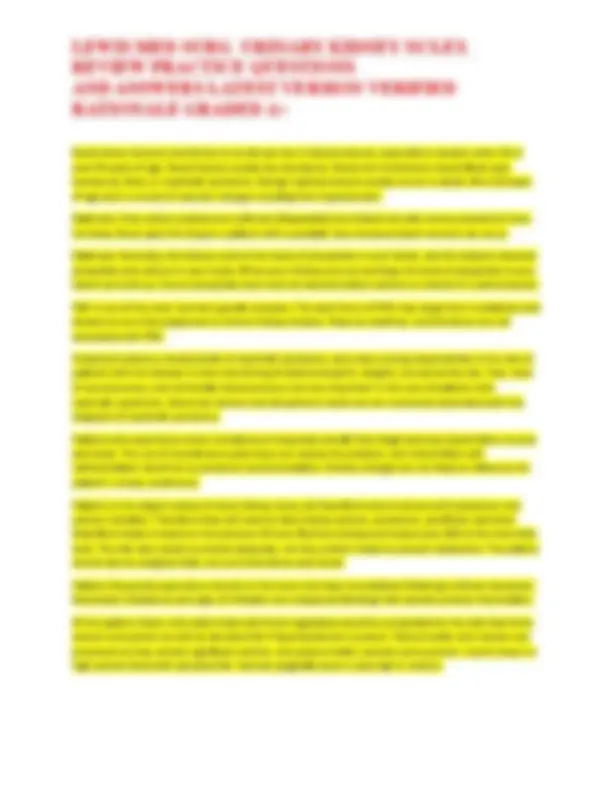
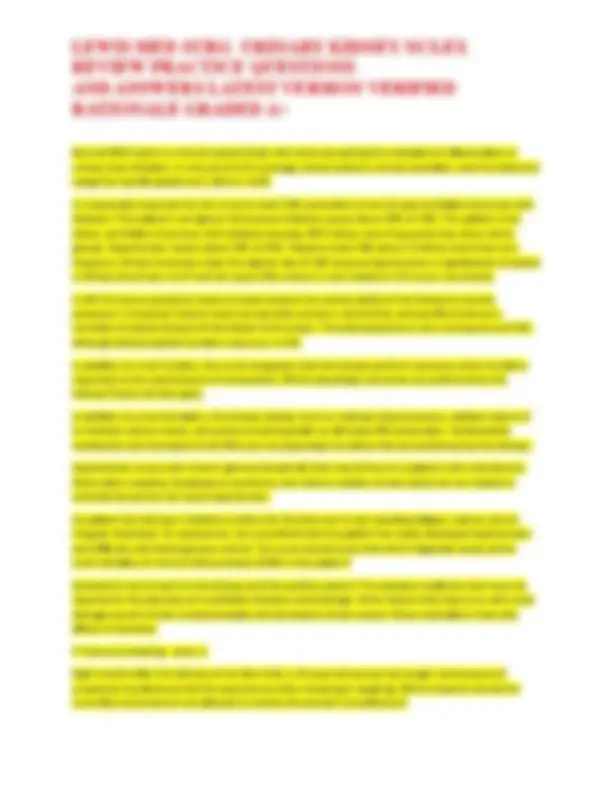
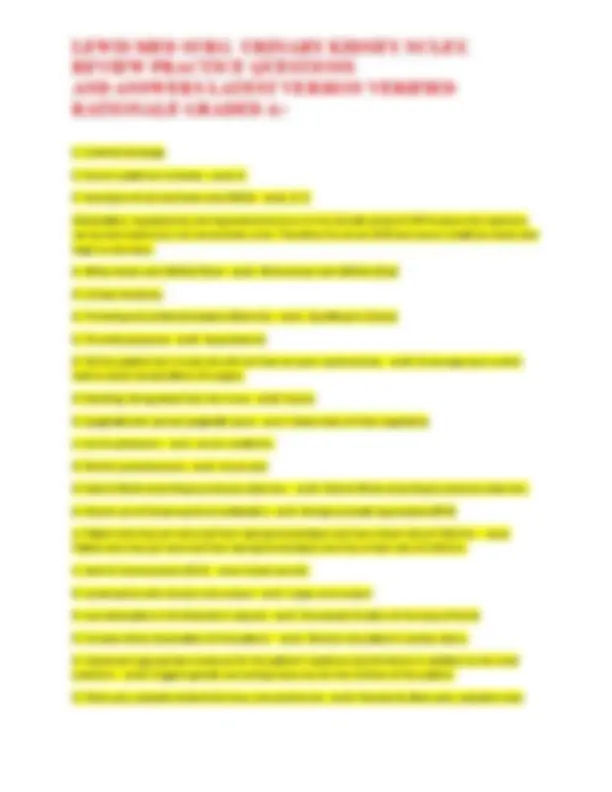
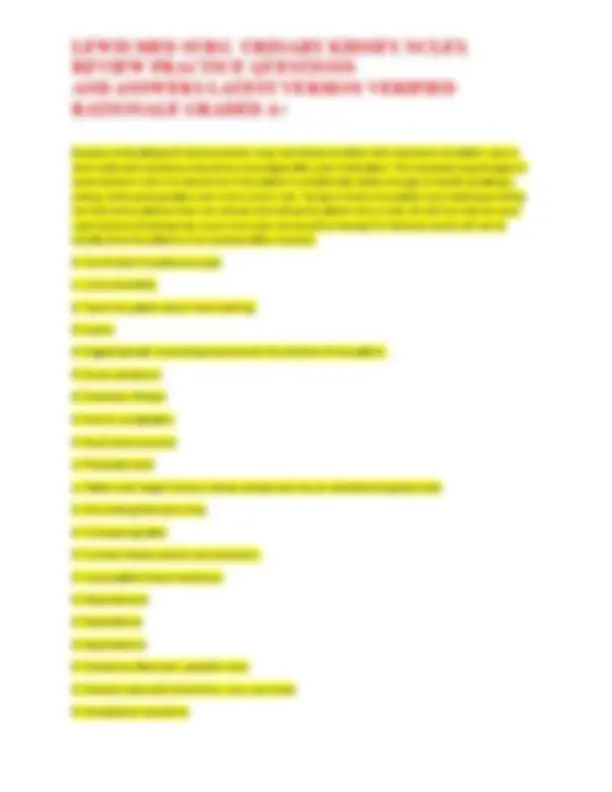
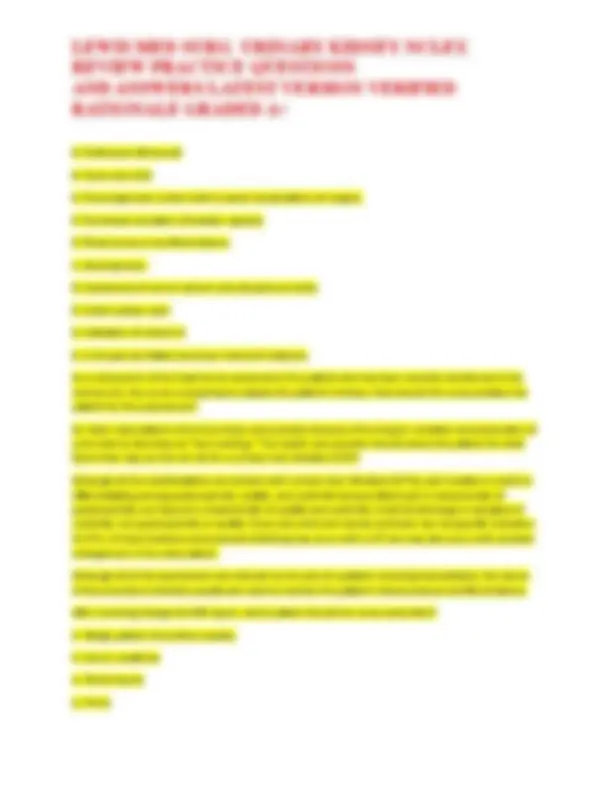
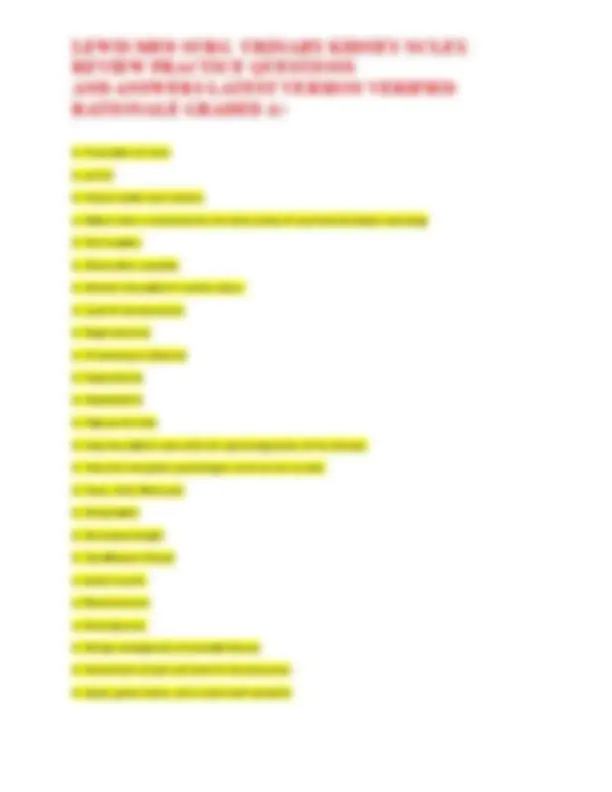





Study with the several resources on Docsity

Earn points by helping other students or get them with a premium plan


Prepare for your exams
Study with the several resources on Docsity

Earn points to download
Earn points by helping other students or get them with a premium plan
Community
Ask the community for help and clear up your study doubts
Discover the best universities in your country according to Docsity users
Free resources
Download our free guides on studying techniques, anxiety management strategies, and thesis advice from Docsity tutors
LEWIS MED SURG URINARY KIDNEY NCLEX REVIEW PRACTICE QUESTIONS.pdf
Typology: Exams
1 / 15

This page cannot be seen from the preview
Don't miss anything!










Which urinalysis result should the nurse recognize as an abnormal finding? Which patient should be taught preventive measures for CKD by the nurse because this patient is most likely to develop CKD? Which nursing intervention is most appropriate in providing care for an adult patient with newly diagnosed adult onset polycystic kidney disease (PKD)? Which nursing diagnosis is a priority in the care of a patient with renal calculi? Which information will the nurse monitor in order to determine the effectiveness of prescribed calcium carbonate (Caltrate) for a patient with chronic kidney disease (CKD)? Which effect of aging on the urinary system is most likely to affect the action of bumetanide (Bumex)? Which assessment finding is a consequence of the oliguric phase of AKI? When the patient selects an apple, green beans, and a roast beef sandwich, the patient demonstrates understanding of the low potassium diet. Granola, dried fruits, nuts and seeds, milk products, chocolate sauce, bran cereal, banana, and orange juice all have elevated levels of potassium, at or above 200 mg per 1/2 cup. When caring for a patient with nephrotic syndrome, the nurse should know the patient understands dietary teaching when the patient selects which food item? When caring for a patient during the oliguric phase of acute kidney injury (AKI), what is an appropriate nursing intervention? Urinary stones are associated with severe abdominal or flank pain. Deficient fluid volume is unlikely to result from urinary stones, whereas constipation is more likely to be an indirect consequence rather than a primary clinical manifestation of the problem. The presence of pain supersedes powerlessness as an immediate focus of nursing care. To palpate the right kidney, the patient is positioned supine, and the nurse's left hand is placed behind and supports the patient's right side between the rib cage and the iliac crest. The right flank is elevated with the left hand, and the right hand is used to palpate deeply for the right kidney. The normal-sized left kidney is rarely palpable because the spleen lies directly on top of it. This UTI is a complicated UTI because the patient has type 2 diabetes and the UTI is recurrent. Ciprofloxacin (Cipro) would be used for a complicated UTI. Fosfomycin (Monurol), nitrofurantoin (Macrodantin), and trimethoprim/sulfamethoxazole (Bactrim) should be used for uncomplicated UTIs. There are no characteristic early symptoms of renal carcinoma. The classic manifestations of gross hematuria, flank pain, and a palpable mass are those of advanced disease.
The urinalysis of a male patient reveals a high microorganism count. What data should the nurse use to determine the area of the urinary tract that is infected (select all that apply)? The patient with type 2 diabetes has a second UTI within one month of being treated for a previous UTI. Which medication should the nurse expect to teach the patient about taking for this infection? The patient was diagnosed with prerenal AKI. The nurse should know that what is most likely the cause of the patient's diagnosis? The patient in the intensive care unit is receiving gentamicin for pneumonia from Pseudomonas. What assessment results should the nurse report to the health care provider? The patient has scleroderma and is experiencing hypertension. The nurse should know that this could be related to which renal problem? The patient has a form of glomerular inflammation that is progressing rapidly. She is gaining weight, and the urine output is steadily declining. What is the priority nursing intervention? The nurse's priority is to monitor the patient's cardiac status. With the rapidly progressing glomerulonephritis, renal function begins to fail and fluid, potassium, and hydrogen retention lead to hypervolemia, hyperkalemia, and metabolic acidosis. Excess fluid increases the workload of the heart, and hyperkalemia can lead to life-threatening dysrhythmias. Teaching about hand washing and observation of the patient are important nursing interventions but are not the priority. Electrolyte measurement is a collaborative intervention that will be done as ordered by the health care provider. The nurse knows the patient with AKI has entered the diuretic phase when what assessments occur? Select all that apply. The nurse is providing care for a patient who has been admitted to the hospital for the treatment of nephrotic syndrome. What are priority nursing assessments in the care of this patient? The best study to determine kidney function or chronic kidney disease (CKD) that would be expected in the patient with diabetes is the calculated GFR that is obtained from the patient's age, gender, race, and serum creatinine. It would need to be abnormal for 3 months to establish a diagnosis of CKD. A creatinine clearance test done with a blood sample and a 24-hour urine collection is also important. Serum creatinine is not the best test for CKD because the level varies with different patients. Serum potassium levels could explain why the patient has an irregular heartbeat. The finding of microalbuminuria can alert the patient with diabetes about potential renal involvement and potentially failing kidneys. However, urine albumin levels are not used for diagnosis of CKD. Sodium polystyrene sulfonate (Kayexalate) is ordered for a patient with hyperkalemia. Before administering the medication, the nurse should assess the
Normal WBC levels in urine are below 5/hpf, with levels exceeding this indicative of inflammation or urinary tract infection. A urine pH of 6.0 is average; amber yellow is normal coloration, and the reference ranges for specific gravity are 1.003 to 1.030. It is especially important for the nurse to teach CKD prevention to the 61-year-old Native American with diabetes. This patient is at highest risk because diabetes causes about 50% of CKD. This patient is the oldest, and Native Americans with diabetes develop CKD 6 times more frequently than other ethnic groups. Hypertension causes about 25% of CKD. Hispanics have CKD about 1.5 times more than non- Hispanics. African Americans have the highest rate of CKD because hypertension is significantly increased in African Americans. A UTI will not cause CKD unless it is not treated or UTIs occur recurrently. In AKI the serum potassium levels increase because the normal ability of the kidneys to excrete potassium is impaired. Sodium levels are typically normal or diminished, whereas fluid volume is normally increased because of decreased urine output. Thrombocytopenia is not a consequence of AKI, although altered platelet function may occur in AKI. In addition to urine function, the nurse recognizes that the kidneys perform numerous other functions important to the maintenance of homeostasis. Which physiologic processes are performed by the kidneys? Select all that apply. In addition to urine formation, the kidneys release renin to maintain blood pressure, activate vitamin D to maintain calcium levels, and produce erythropoietin to stimulate RBC production. Carbohydrate metabolism and hemolysis of old RBCs are not physiologic functions that are performed by the kidneys. Hypertension occurs with chronic glomerulonephritis that may be found in patients with scleroderma. Obstructive uropathy, Goodpasture syndrome, and calcium oxalate urinary calculi are not related to scleroderma and do not cause hypertension. he patient has had type 1 diabetes mellitus for 25 years and is now reporting fatigue, edema, and an irregular heartbeat. On assessment, the nurse finds that the patient has newly developed hypertension and difficulty with blood glucose control. The nurse should know that which diagnostic study will be most indicative of chronic kidney disease (CKD) in this patient? Gentamicin can be toxic to the kidneys and the auditory system. The elevated creatinine level must be reported to the physician as it probably indicates renal damage. Other factors that may occur with renal damage would include increased weight and decreased urinary output. Many medications have side effects of anorexia. F. Post-void dribbling - ansA, E. Eight months after the delivery of her first child, a 31-year-old woman has sought care because of occasional incontinence that she experiences when sneezing or laughing. Which measure should the nurse first recommend in an attempt to resolve the woman's incontinence?
E. Urethral discharge E. Serum creatinine increases - ansA, B. E. Hemolysis of old red blood cells (RBCs) - ansA, B, D. Dehydration, hypokalemia, and hyponatremia occur in the diuretic phase of AKI because the nephrons can excrete wastes but not concentrate urine. Therefore the serum BUN and serum creatinine levels also begin to decrease. D. White blood cells (WBCs) 9/hpf - ansD. White blood cells (WBCs) 9/hpf D. Urinary hesitancy D. Trimethoprim/sulfamethoxazole (Bactrim) - ansA. Ciprofloxacin (Cipro) D. Thrombocytopenia - ansB. Hyperkalemia D. Tell the patient she is lucky she did not have an open nephrectomy. - ansB. Encourage even a short walk to avoid complications of surgery. D. Standing, facing away from the nurse - ansB. Supine D. Spaghetti with canned spaghetti sauce - ansC. Salad made of fresh vegetables d. serum potassium. - ansc. serum creatinine. D. Risk for powerlessness - ansA. Acute pain D. Restrict fluids according to previous daily loss. - ansD. Restrict fluids according to previous daily loss. D. Recent use of broad-spectrum antibiotics - ansC. Benign prostatic hyperplasia (BPH) d. Patient who has just returned from having hemodialysis and has a heart rate of 124/min. - ansd. Patient who has just returned from having hemodialysis and has a heart rate of 124/min. d. level of consciousness (LOC). - ansa. bowel sounds. D. Leukocytosis with cloudy urine output - ansC. Large urine output D. Less absorption in the Bowman's capsule - ansC. Decreased function of the loop of Henle D. Increase direct observation of the patient. - ansA. Monitor the patient's cardiac status. D. Implement appropriate measures for the patient's deafness and blindness in addition to the renal problems. - ansB. Suggest genetic counseling resources for the children of the patient. D. Flank pain, palpable abdominal mass, and proteinuria - ansB. Hematuria, flank pain, palpable mass
C. Obtain a serum specimen for electrolytes. C. Nitrofurantoin (Macrodantin) c. Neurologic status C. Microalbuminuria C. Mental confusion C. Large urine output C. Intermittent self-catheterization C. Increased urinary output C. Hypernatremia C. Hypernatremia C. Hematuria, proteinuria, palpable mass C. Expect the patient to have polyuria and poor concentration ability of the kidneys. C. Deficient fluid volume C. Decreased function of the loop of Henle C. Chronic glomerulonephritis C. Carbohydrate metabolism c. blood urea nitrogen (BUN). C. Blood pressure and assessment for orthostatic hypotension C. Benign prostatic hyperplasia (BPH) C. A 40-year-old Hispanic female with cardiovascular disease Bumetanide (Bumex) is a loop diuretic that acts in the loop of Henle to decrease reabsorption of sodium and chloride. Because the loop of Henle loses function with aging, the excretion of drugs becomes less and less efficient. Thus the circulating levels of drugs are increased and their effects prolonged. The benign enlargement of prostatic tissue, decreased sensation of bladder capacity, and loss of concentrating ability do not directly affect the action of loop diuretics. BPH causes urinary stasis, which is a predisposing factor for UTIs. A sedentary lifestyle and recent antibiotic use are unlikely to contribute to UTIs, whereas a diet high in purines is associated with renal calculi.
Because ambulating will improve bowel, lung, and kidney function with improved circulation, even a short walk with assistance should be encouraged after pain medication. The transplant psychologist or social worker's role is to determine if the patient is emotionally stable enough to handle donating a kidney, while postoperative care is the nurse's role. Trying to shame the patient into walking by telling her that other patients have not refused and telling the patient she is lucky she did not have an open nephrectomy (implying how much more pain she would be having if it had been open) will not be beneficial to the patient or her postoperative recovery. B. Use of adult incontinence pads b. urine osmolality. B. Teach the patient about hand washing. B. Supine B. Suggest genetic counseling resources for the children of the patient. B. Serum potassium B. Sedentary lifestyle B. Risk for constipation B. Renal artery stenosis b. Phosphate level b. Patient with stage 4 chronic kidney disease who has an elevated phosphate level B. One small grilled pork chop B. Increased appetite B. Increase dietary sodium and potassium. B. Incompatible blood transfusion B. Hyponatremia B. Hypokalemia B. Hyperkalemia B. Hematuria, flank pain, palpable mass B. Granola made with dried fruits, nuts, and seeds B. Goodpasture syndrome
A. Production of renin A. pH 6. A. Peanut butter and crackers a. Patient who is scheduled for the drain phase of a peritoneal dialysis exchange A. Pain location A. Obstructive uropathy A. Monitor the patient's cardiac status. A. Level of consciousness A. Kegel exercises A. IV tobramycin (Nebcin) A. Hypovolemia A. Hypokalemia A. High-purine diet A. Help the patient cope with the rapid progression of the disease. A. Have the transplant psychologist convince her to walk. A. Fever, chills, flank pain A. Dehydration A. Decreased weight A. Ciprofloxacin (Cipro) a. bowel sounds. a. Blood pressure a. blood glucose. A. Benign enlargement of prostatic tissues A. Assessment of pain and level of consciousness A. Apple, green beans, and a roast beef sandwich
A. Acute pain A. A 50-year-old white female with hypertension A patient with diabetes who has bacterial pneumonia is being treated with IV gentamicin (Garamycin) 60 mg IV BID. The nurse will monitor for adverse effects of the medication by evaluating the patient's A patient with a history of end-stage kidney disease secondary to diabetes mellitus has presented to the outpatient dialysis unit for his scheduled hemodialysis. Which assessments should the nurse prioritize before, during, and after his treatment? A patient is recovering in the intensive care unit (ICU) after receiving a kidney transplant approximately 24 hours ago. What is an expected assessment finding for this patient during this early stage of recovery? A nurse is admitting a patient with the diagnosis of advanced renal carcinoma. Based upon this diagnosis, the nurse will expect to find what clinical manifestations as the "classic triad" occurring in patients with renal cancer? A dissecting abdominal aortic aneurysm is a prerenal cause of AKI because it can decrease renal artery perfusion and therefore the glomerular filtrate rate. Aminoglycoside antibiotic administration, a hemolytic blood transfusion reaction, and poststretpcoccal glomerulonephritis are intrarenal causes of AKI. A 78-year-old patient has Stage 3 CKD and is being taught about a low potassium diet. The nurse knows the patient understands the diet when the patient selects which foods to eat? A 24-year-old female donated a kidney via a laparoscopic donor nephrectomy to a non-related recipient. The patient is experiencing a lot of pain and refuses to get up to walk. How should the nurse handle this situation? A 22-year-old patient's blood pressure at her physical done for her new job was 110/68. At the health fair two months later, her blood pressure is 154/96. What renal problem should the nurse be aware of that could contribute to this abrupt rise in blood pressure?